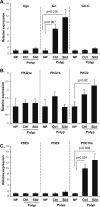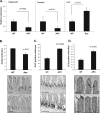Cyclic-GMP-Elevating Agents Suppress Polyposis in ApcMin mice by Targeting the Preneoplastic Epithelium
- PMID: 29301746
- PMCID: PMC5811348
- DOI: 10.1158/1940-6207.CAPR-17-0267
Cyclic-GMP-Elevating Agents Suppress Polyposis in ApcMin mice by Targeting the Preneoplastic Epithelium
Abstract
The cGMP signaling axis has been implicated in the suppression of intestinal cancers, but the inhibitory mechanism and the extent to which this pathway can be targeted remains poorly understood. This study has tested the effect of cGMP-elevating agents on tumorigenesis in the ApcMin/+ mouse model of intestinal cancer. Treatment of ApcMin/+ mice with the receptor guanylyl-cyclase C (GCC) agonist linaclotide, or the phosphodiesterase-5 (PDE5) inhibitor sildenafil, significantly reduced the number of polyps per mouse (67% and 50%, respectively). Neither of the drugs affected mean polyp size, or the rates of apoptosis and proliferation. This was possibly due to increased PDE10 expression, as endogenous GCC ligands were not deficient in established polyps. These results indicated that the ability of these drugs to reduce polyp multiplicity was primarily due to an effect on nonneoplastic tissues. In support of this idea, ApcMin/+ mice exhibited reduced levels of endogenous GCC agonists in the nonneoplastic intestinal mucosa compared with wild-type animals, and this was associated with crypt hyperplasia and a loss of goblet cells. Administration of either sildenafil or linaclotide suppressed proliferation, and increased both goblet cell numbers and luminal apoptosis in the intestinal mucosa. Taken together, the results demonstrate that targeting cGMP with either PDE5 inhibitors or GCC agonists alters epithelial homeostasis in a manner that reduces neoplasia, and suggests that this could be a viable chemoprevention strategy for patients at high risk of developing colorectal cancer. Cancer Prev Res; 11(2); 81-92. ©2018 AACR.
©2018 American Association for Cancer Research.
Conflict of interest statement
The authors declare no potential conflicts of interest.
Figures






References
-
- Gwyn K, Sinicrope FA. Chemoprevention of colorectal cancer. Am J Gastroenterol. 2002;97(1):13–21. - PubMed
-
- Thompson WJ, Piazza GA, Li H, Liu L, Fetter J, Zhu B, et al. Exisulind induction of apoptosis involves guanosine 3',5'-cyclic monophosphate phosphodiesterase inhibition, protein kinase G activation, and attenuated beta-catenin. Cancer Res. 2000;60(13):3338–42. - PubMed
Publication types
MeSH terms
Substances
Grants and funding
LinkOut - more resources
Full Text Sources
Other Literature Sources

